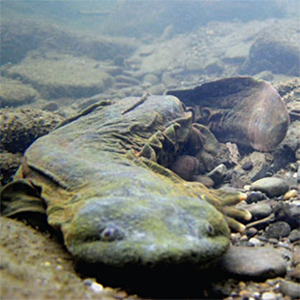Hellbenders' Friend

Eastern hellbender salamander
Eric Chapman, WPC’s director of aquatic science, leads the Conservancy’s efforts to study and protect the eastern hellbender salamander. Chapman and his colleagues’ efforts include working with partners to ascertain the status of the hellbender in Western Pennsylvania; collaborating with the Pittsburgh Zoo & PPG Aquarium to document population dynamics; working with Clarion University to test hellbenders for Chytrid fungus, which has been decimating other amphibians; and protecting and improving the quality of streams that harbor the hellbender. Here, Chapman talks with Conserve about his fondness for this unusual creature.
What are eastern hellbender salamanders and where are they found? Are they easy to spot?
Eastern hellbenders, which can grow to 30 inches, are the largest salamander species found in the United States. They are an aquatic species that inhabit large streams and rivers. Their distribution in Pennsylvania is in the Ohio, Allegheny, and Susquehanna watersheds, with most animals being found in tributaries to these large systems.
Hellbenders are difficult to find for several reasons. First, hellbenders require exemplary water quality in order to survive and reproduce. Habitat loss due to dams, poor agricultural practices, heavy logging and acid mine drainage effects has greatly reduced hellbender populations. Second, hellbenders live under large, heavy rocks that require numerous people to lift. Catching a hellbender is a skill that I equate to blindly trying to grab a water balloon covered with mucus underwater — definitely a learned skill.
What do hellbenders eat?
Hellbenders feed almost exclusively on crayfish. In winter, when crayfish become less active, they feed on several minnow species and hellgrammites. They will also eat their own eggs during breeding season.
Hellbenders are very large compared to other species of salamanders. Do they tend to frighten people?
I have seen some pretty interesting reactions to first-time hellbender encounters, which have included a 6’ 9” man squealing when he tried to grab one. Most people can’t believe how big they are and that they have never seen one before, even though they often have been fishing, canoeing, and hiking in or near streams inhabited by hellbenders. Hellbenders have small eyes, flattened bodies, and beautifully keeled tails. They elicit responses of either love or hate; they are truly unique-looking and perfectly adapted for how they make their livings — hunting crayfish under large rocks in the dark.
Are hellbenders at risk? Why?
Hellbenders could be at risk, but we don’t know for sure, because many locations haven’t been sampled in over 50 years. We hope to fill in gaps in data that would answer that question for us. Additional funding is necessary to survey all of the animal’s historical ranges in Pennsylvania.
What would you like people to know about hellbenders?
That they are an amazing species that can live for up to fifty years! They are a testament to how important water quality is to the long-term health of a stream and its inhabitants. Hellbenders should be treated with care and respect. If they are caught inadvertently while fishing, they should be carefully released because they do not eat trout and destroy fisheries, contrary to popular belief.
What do you find interesting or rewarding about working with hellbenders?
I find it rewarding to study an animal that so few people have ever seen. When we are doing a survey and an animal escapes, it is mindboggling to me that a two-foot salamander can “disappear” in 14 inches of water — they have such remarkable camouflage. I enjoy seeing people’s faces the first time they touch a hellbender; they are a truly remarkable animal.
I Heart Hellbenders!

Celebrate one of Western Pennsylvania’s rarest creatures this holiday season with hellbender t-shirts for friends and family!
